TDA7297 / TDA7266 DIY Guide - 15W / 7W Stereo Bridge Single Chip Power Amplifiers
The TDA7297 and TDA7266 (TDA7266D13TR) are both bestselling amplifier chips that are still readily available as of August 2020. They allow you to easily build high performance stereo amplifiers.
Recommended Experience : Beginner to Intermediate, knowledge of amplifiers, heatsink attaching
TDA7297 application
Quick facts TDA7297
- Power output: 15W + 15W into 8 ohms at 10% 1kHz distortion with power supply 16.5V
- Power output: 12W + 12W into 8 ohms at 1% 1kHz distortion with power supply 16.5V
- Power output: 8W + 8W into 8 ohms at 10% 1kHz distortion with power supply 12V
- Power output: 6W + 6W into 8 ohms at 1% 1kHz distortion with power supply 12V
- Gain: 32dB fixed
- Power supply: 6V to 18V single supply
- Class AB
- Datasheet available here
Guide
The TDA7297 is a simple to build stereo/dual amplifier that can deliver a rather good amount of power into 8 ohm speakers from just a single rail power supply of 12V, and even more power when supplied with around 17V.
The application is intended for TV and Portable Radio applications, but has a wide range of possibilities:
- It is a capable amp for a stereo system (i.e. a homemade or upgraded midi system or 'ghetto-Blaster')
- A pair could be used to make a complete surround sound system (i.e. front and rear channel amps), especially if combined with an active subwoofer
- Decent quality PC speakers
- Stereo or Bi-amplified Bluetooth speaker
- A pair could make a Bi-amplified sound system
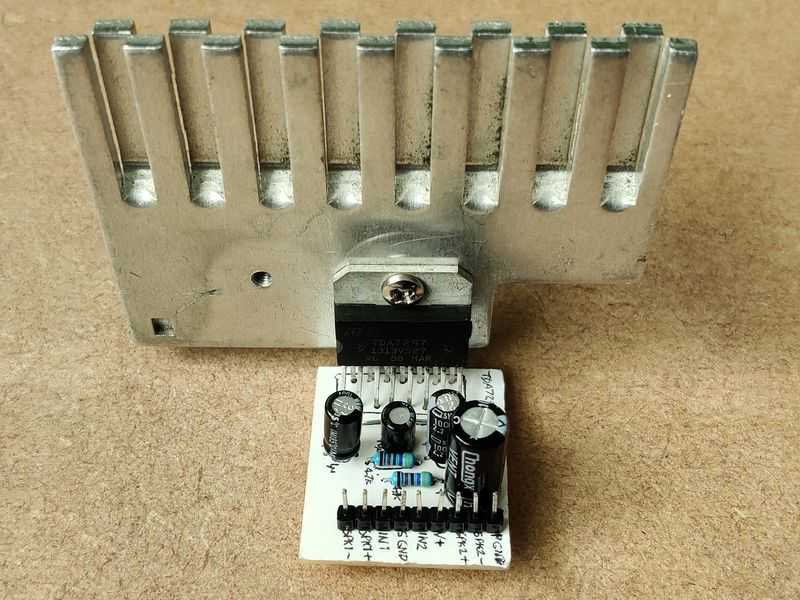
This amplifier is based on the typical application in the ST Microelectronics datasheet. The performance from this circuit is good. The data sheet contains typical noise and distortion statistics. Whilst I can't confirm these statistics, the output from this amplifier does sound pretty great for how simple it is!
Apart from subwoofer use, and high-power sound systems, there's really not many applications this chip can't meet! You may want to consider the TDA7266 detailed below for lower powered applications, but for a stereo system, I can't see any advantage really smaller chips like the LM386, TDA2822M and so on would provide over this. The PCB is small and simple, and you get a stereo output too. It'll also work on Stripboard / Veroboard with some careful pin bending.
The datasheet only has statistics and information about performance into 8 ohm speakers, however the amplifier does appear to work fine into 4 ohm speakers too, but performance is unknown and expected to be worse. As the TDA7297 output is two amplifiers bridged together per speaker, an 8 ohm speaker look like 4 ohms to each individual amplifier inside the chip (therefore 4 ohms will look like 2 ohms). If driving 4 ohms, I would recommend the power supply is kept below 14V. In my testing, 4 ohm speakers on a 12V power supply worked fine. You can expect around 15W per channel in this case.
For the best 4 ohm capability, the STA540 / TDA7375 or similar can be considered instead. Its circuit is almost as simple.
For those whose application really doesn't need a dual/stereo amplifier (and bi-amplification would not be any consideration), there is a mono alternative TDA7266M or TDA7391 to name two. The TDA7297 could also provide one channel by leaving the second output disconnected, and the second input grounded via the capacitor on that input (e.g. C5).
Note: The TDA7297 already has two bridged outputs, you cannot bridge them again to make a (say) 32W mono amp. An amplifier can only be bridged once. A parallel bridge configuration (which would allow driving lower impedance loads) isn't mentioned in the datasheet as supported and very few amplifiers will support it because it requires both bridged stereo amplifiers to have exactly the same gain. As the TDA7297 has a gain matching of only 0.5dB, the two halves are not matched and the one with the highest gain will do all the work. You may have success using some large resistors on all outputs to try enforcing load sharing, but efficiency will suffer, and distortion may be increased noticeably in this configuration.
To obtain more power off the same voltage supply, I suggest considering an alternative chip such as the TDA7396 into mono 2 ohms to get a high power output. Alternatively, consider bi-amplifying by using two speakers and an active crossover before the amplifier. A crossover point of 350Hz would distribute the power equally to bass and mid/high and the power of the two 8W TDA7297 halves could have an emulated power of up to 32W. You would need two appropriate speakers and the active crossover though.
Circuit
There are two types of application for the TDA7297.
- The full application that allows the standby and mute pins to be controlled by a microprocessor
- The low-cost application that's just an amp that will power on and unmute shortly after the power is applied
Low-cost application
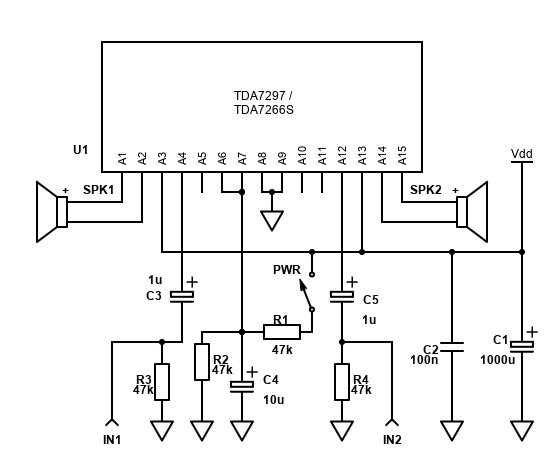
This is the application that is suitable for most DIY home builds where no microprocessor needs to be involved. It is basically figure 3 of the datasheet, but with some resistors added across the inputs to give the amplifier a suitable input impedance, and avoid bangs when plugging source systems into the input connectors (if you had external phono or 3.5mm inputs for example).
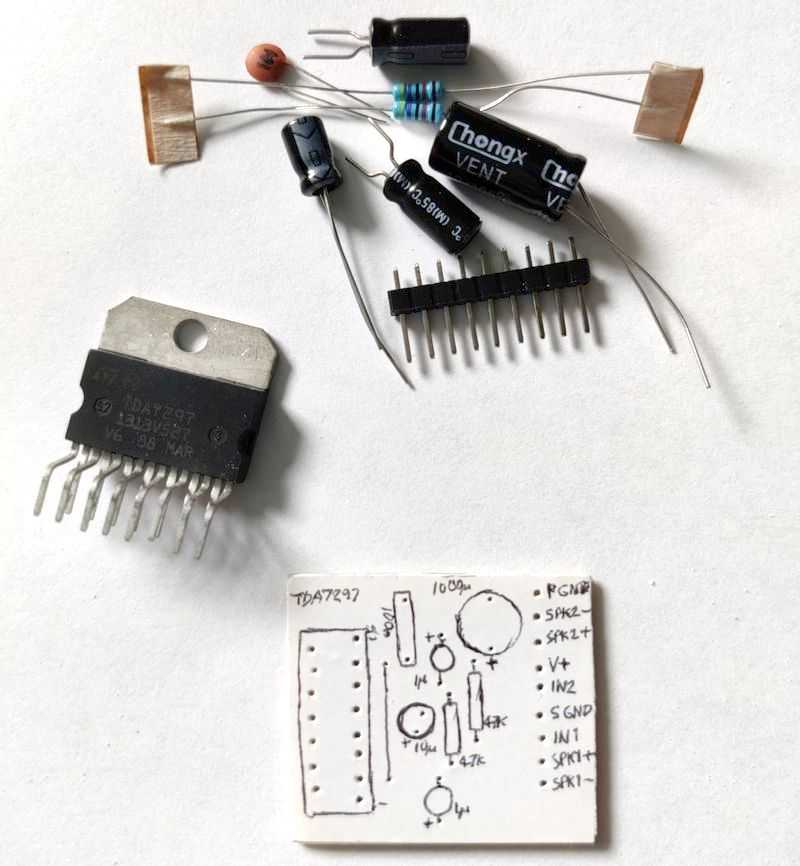
Above: All the parts you need to build an amplifier!
The TDA7297 is best with a custom PCB, and my PCB Building guide has information on how you can draw and etch a custom PCBs. The layout below shows how small it can be.
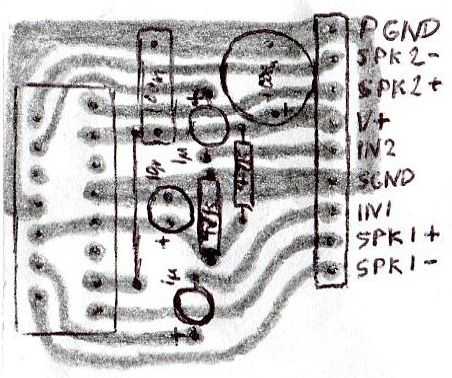
This is my hand drawn style that can simply be reversed and drawn as a copy onto single sided copper board. The DPI of this image should print to the exact size you need, which is 30mm x 30mm. Note that R3 and R4 are not included in this layout, but can be accommodated easily enough.
If you want to build on stripboard / Veroboard though, it can be done too!
The chip was not designed to fit into pre-made board, but by bending the front pins slightly to the left (very carefully), they'll align into 2.54mm stripboard just fine. Below is a photo of the same done for a TDA7266 chip.
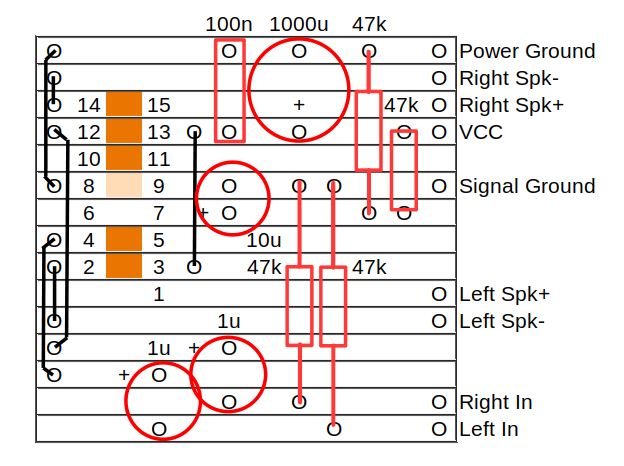
This suggested layout I've built and tested. It's designed so you can mount the board onto a heatsink without the board extending into the heatsink area. There is a lot of jumpers to install on the furthermost side though!
The areas in dark orange must be cut so that the strip is electronically separated. The light orange area can be optionally cut if your system layout requires the power and signal grounds to be joined at another point. I suggest joining them on the board though and keep this trace connecting pins 8 and 9 together.
The two 47k resistors (R3 and R4) leading to the left and right inputs are optional (bottom right). They prevent popping noises if you connect phono / 3.5mm inputs etc. whilst the amplifier is on, and also make it stable for a variety of sources (including mobile phone outputs) by providing a reasonable input impedance. You can leave them out, or optionally install them on the sockets directly.
Below are pictures of my completed layout. The chip is actually the TDA7266S, but the same layout is used.
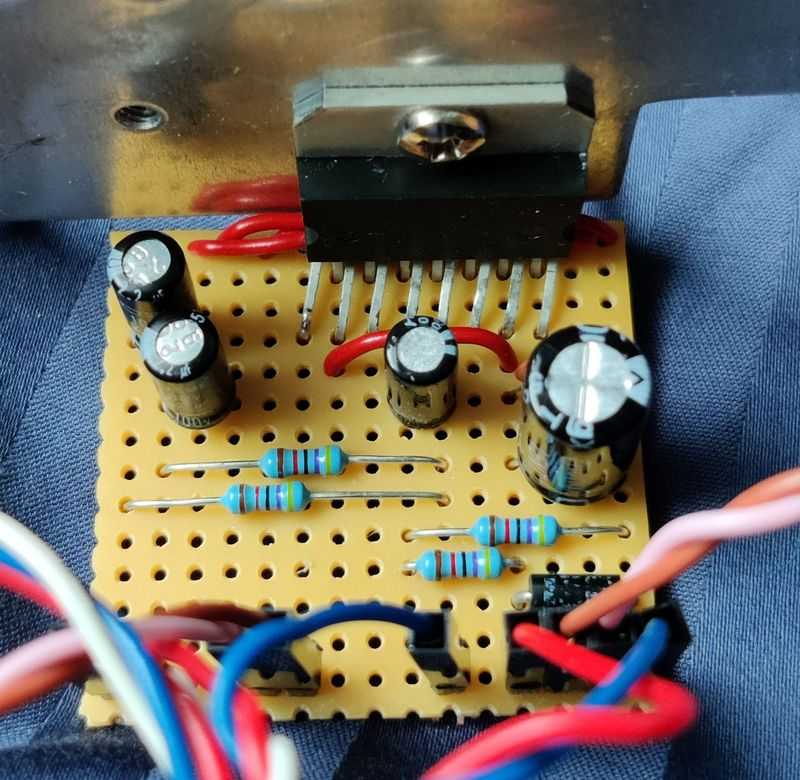
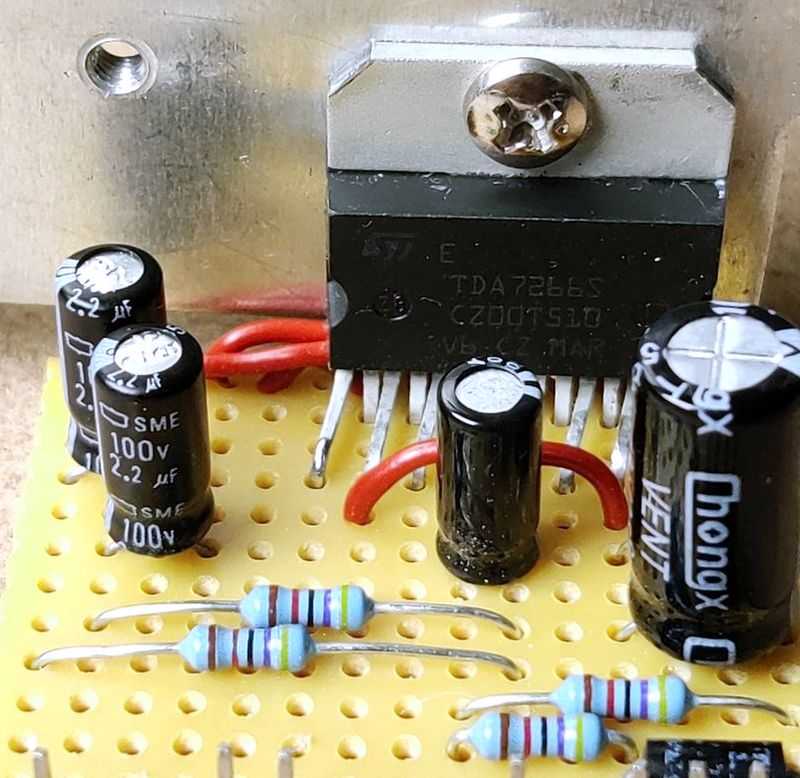
Note that I also included (and my original schematic also included) a diode with the cathode in the positive power supply and the anode in ground. This protects the amplifier from a power supply connected in reverse (but would not protect the power supply and assumes that the PSU would shut down or blow a fuse in this case). It's completely optional and if you were to include it in your build too, then a rectifier diode capable of handling the current until the PSU shuts down or the fuse would do e.g. 1N4007.
Microprocessor controlled application
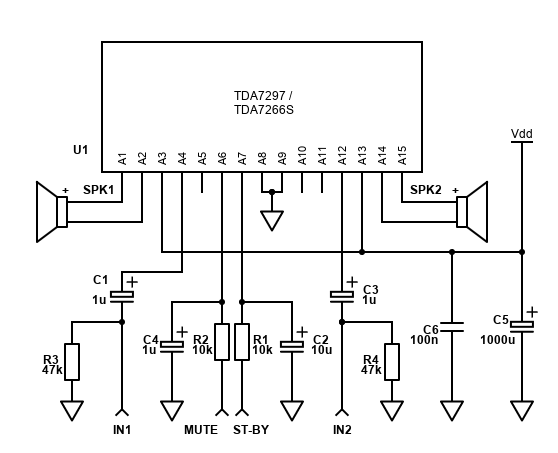
This application is figure 1 in the datasheet. It shows how the mute and standby pins can be connected to a microprocessor.
The microprocessor can be an Arduino, PIC or similar MCU, or it can be the GPIO pins of a Raspberry Pi or similar computer. My wake-up light radio (under construction) has the Raspberry Pi successfully controlling the TDA7297.
One caution with 3.3V signals to control the mute is that the threshold voltage can be up to 4.1V per the datasheet. You might be fine, but you may get 10dB or worse attenuation. To avoid that risk, you can level shift the output of the MCU by using a 2N7000 MOSFET in this configuration.

The 5V input may be from the Raspberry Pi 5V pins if you have that or another 5V supply. Alternatively, you can make a voltage divider to give half the amplifiers voltage supply for the mute pin.
The datasheet gives a timing suggestion of 100ms to 200ms between the amplifier exiting standby and the amplifier unmuted to avoid any popping noises.
Components
| # | Type | Quantity |
|---|---|---|
| U1 | TDA7297 or TDA7266 | 1 |
| R1,R2,R3,R4 | 47k ohm Resistor, ¼W Metal Film, 1% | 4 |
| C1 | 1000µF Capacitor, 25V+ Electrolytic | 1 |
| C2 | 100nF Capacitor, 50V+ Ceramic X7R or MLCC | 1 |
| C3,C5 | 1µF Capacitor, Polyester Film/Box (Best) or 16V+ Electrolytic | 2 |
| C4 | 10µF Capacitor, 25V+ Electrolytic | 1 |
| In L,R,SGND,+Vs,GND,SPK | 2.54mm header 9-pin | 1 |
| Heatsink, cable, connectors | ~ |
Like all amplifiers, the TDA7297 needs bypass capacitors C1 and C2 (C5 and C6 for the microprocessor version). That's a 220µF or better (I used 1000µF) electrolytic capacitor, and a 100nF ceramic or multi-layer ceramic (MLCC) capacitor. Make sure the electrolytic is orientated correctly with + in the positive power supply.
Both C1 and C2 need to be as close to the amplifier pins as possible, with C2 (the 100nF ceramic) being the closest. As pin 3 and 13 are quite far apart, for the best power supply bypassing, you may prefer to add a second 100nF capacitor (same as C2) from pin 13 to ground as well as pin 3 to ground.
C1 needs to have a voltage rating of a few volts or more greater than the power supply you want to use. Therefore, a 16V capacitor is fine for a 12V PSU, but if you want to go higher with the voltage, get a 25V or 35V rated capacitor. I've suggested 1,000µF for C1, but if you have a good power supply with capacitance exceeding this already, then C1 can be dropped to 470µF or 220µF.
As the TDA7297 is a single supply amplifier, it generates a virtual ground internally that is half the supply voltage. This allows the audio input signal to swing above and below this virtual ground.
The input capacitors C3 and C5 protect that DC voltage offset from reaching your input source. These are 0.22µF (220nF) input capacitors in the datasheet, but you can raise these to 1µF to get the best bass response. I used 2.2µF. Polyester is preferred for best audio quality, but an electrolytic works fine too and unless you're using this amp for the absolute best speakers in a quiet environment, you'll unlikely to notice the difference. The + pin of the electrolytic must be facing the amplifier pins.
The voltage the capacitor needs to handle is half the supply voltage plus the peak AC input (no more than 2V), a 16V rated capacitor is fine for C3 and C5, but 1µF electrolytic capacitors are usually 50V or 63V rated or higher anyway.
Note: If you've ordered a cheap TDA7297 from China / East Asia - not only are you probably getting a fake TDA7297 that doesn't perform as well, but you're also given multi-layer ceramic capacitors for C3/C5. These are not recommended for audio.
In the low-cost application, we need a couple of resistors, R1 and R2 are a voltage divider to generate a half supply voltage to apply to the standby and mute pins. Because there's no audio in these resistors, they can both be any cheap 47k resistor. C4 is an electrolytic capacitor that charges by the voltage divider and 10µF is given in the datasheet.
Because the standby voltage threshold is lower than the mute voltage, C4 will charge to 1.2V through R1 in 470ms in 110ms, causing the amplifier to exit its standby state. Once C4 reaches 2.9V in 320ms, the amplifier will exit its mute state. That ~200ms between the standby threshold and the mute threshold avoids the pops normally caused by applying power to an amplifier without it muted first. This means in almost all applications you won't need to have a relay on the speaker outputs to disconnect/connect speakers for muting purposes. Note: Timings approximate as it depends on your supply voltage and the thresholds your amplifier chip really works on.
As the C4 capacitor is running at half the supply voltage, a 16V rated capacitor is fine. 10µF electrolytic capacitors are usually no smaller than 16V anyway. I've had success increasing the size of C4 to 100µF in order to mute the amplifier long enough after power on following a bass boost circuit which gives a longer power on pop than the 10µF capacitor would mute for.
Do not run this amp without a good heatsink, it will get extremely hot very quickly and shut down. Get a good heatsink, especially at high voltages. The heatsink internally connects to ground which shouldn't cause a problem for most applications, however if your using the amplifier on mains power and your case is earthed (it must be for safety), you may need a loop breaker to avoid hum caused by other equipment that is also earthed, and in this case the TDA7297 would need to be isolated from its heatsink in order to avoid shorting the earthed case to the amplifier power and signal grounds.
When mounting the amplifier chip to the heatsink, also use a line of thermal paste, and let the pressure of screwing it onto the heatsink push out the paste to cover the entire back of the tab. It's important to use thermal paste to improve the heat transfer, but do not use too much.
The gain of the TDA7297 is fixed at about 32dB - that's a voltage gain of 40 times, calculated as 10^(dB/20), so 10^(32/20) = 40). This means, it's pretty sensitive and unlikely to need a preamp. With a 12V input power, the TDA7297 can drive an 8 ohm speaker (which is 4 ohm bridged) to about 6.8W RMS at 1% distortion. To calculate the voltage of this, it's V = √(6.8 * 4) = 5.22V RMS. Divide that by 40 and it's just a 130mV RMS input signal required to drive the TDA7297 to maximum power, without distortion. I found the output from a smartphone or many other sources can easily drive it to clipping.
In the microprocessor application, the datasheet still recommends to have RC networks on the standby and mute pins. This time, 1µF for mute and 10µF for the standby pin (like the low-cost application). These capacitors will charge through a 10k resistor though so their delay will be less (about 85ms for mute and only 3ms for standby with a 5V MCU). The mute will discharge faster if the power is completely removed from the microchip (i.e. not turned off properly), so the amplifier will still mute itself before going into standby, and both of these should happen before the power supply drains if your using a 1000µF capacitor or better there. This ensures no power off pops too.
Making a 'system'
If you want to build your own stereo amplifier system, you'll need a little more than the circuit and components above.
- A power supply - see below, but suggest an external power supply
- A DC jack such as a standard 2.1mm jack. It should match the plug on the power supply
- A power switch, such as a slide switch, toggle switch or latching push button
- A power LED and current limiting resistor (you may have an LED in your power button you can use)
- 3.5mm jack input or phono sockets for connecting your source
- A dual gang potentiometer, 10k log is recommended
- Optional, but recommended, capacitors to block radio interference
- Optional, but recommended, a capacitor and inductor to improve PSU noise
- Optional, but recommended, capacitors in front of potentiometer to block DC
- If your speakers are separate from the amplifier, spring clips, female banana plug sockets or similar should be used to attach/detach the speakers
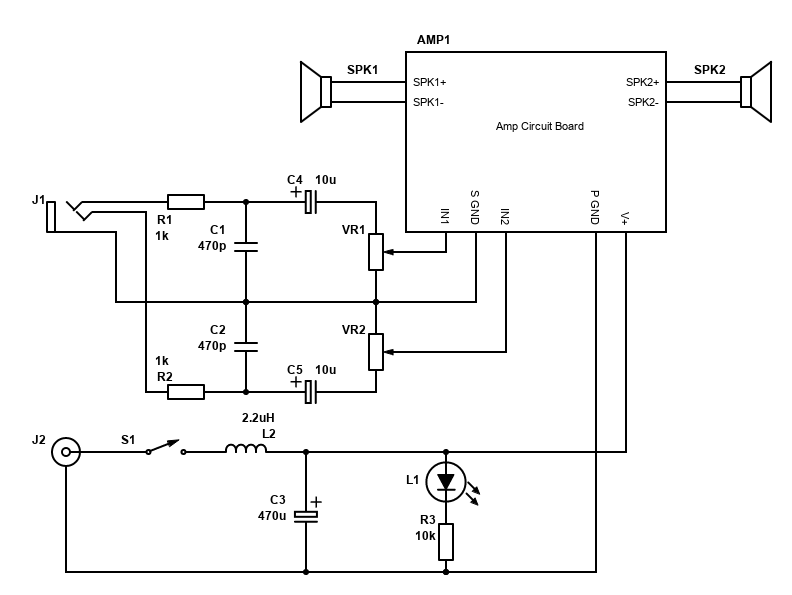
Since the fixed gain is quite high, it's unlikely you'll need a preamplifier and you'll be able to use most sources directly. This could be your TV, smartphone, a Bluetooth audio module, Chromecast audio (if you can find it to buy) or many other devices.
When connecting all connections, tightly twist the related wires together. This is applicable to all related connections where there is a signal and a return, so twist the L/R input with the signal ground together, twist each speaker +/- wires together, and twist the voltage + supply and power ground together.
Twisting related flow/return wires together likes this both prevents them radiating interference, and also protects them from interference. Each twisted set in a system should be kept away from each other and if they must be close, let them cross at right angles and don't run them parallel to each other. This is to reduce hum.
The PCB layouts above have the signal and power grounds joined together at the board, therefore do not have these connecting anywhere else to avoid hum caused by ground loops. If you do have a wider system and have these power and signal grounds joined at another point, consider removing the join at the board and replacing it with a 10 ohm resistor, in parallel with a 100nF capacitor.
The potentiometer should be a dual gang one, so both channels are adjusted together. 10k Log type is ideal. It will have three pins per channel. The first pin will be the one connected to signal ground, the middle pin to the audio input and the final pin as the audio output. This will ensure that turning the volume control clockwise raises the volume, anti-clockwise lowers it.
Before the volume control are a 10µF capacitors on each signal (C4 and C5). These block any DC offset the source may or may not have. DC voltages cause the potentiometer to become noisy over time (particularly when adjusted), so the capacitors improve its life. We don't have to worry about any capacitor after the volume control because the capacitor is the first component in series with the input signal at the amplifier itself.
At the input socket are two RC low pass filter (one for each signal). The component values are not too critical here, it's just to ensure signals of MHz's are removed so with the combination of 1k ohms and 470pF (picofarads), frequencies above 340kHz are removed. This will remove any GSM pulsed buzz / interference from mobile phones, as well as any AM radio stations creeping in.
At the power supply, the switch is first, on the positive line. I suggest to get a latching push button switch with an LED built in for convenience, but check whether the LED needs a resistor or not (some are 12V ready). Otherwise having a separate LED to indicate whether the power is on is useful. The value R3 should be adjusted to suit your power supply and LED type (search for LED resistor calculator).
Then there is a filter formed by a 2.2µH power inductor (capable of handling 6A current) and a 470µF capacitor (this must be a low ESR type). These are there to reduce the ringing/whining noise from noisy SMPS power supplies. Anything above 5kHz on the PSU is cut. You may not need the inductor if your power supply is quiet, but I still suggest the capacitor for smoothing the voltage.
Power Supply
I recommend, especially for beginners, that an external power supply is used. This should be a linear power supply or switching power supply that is suitable for audio/video use (i.e. a 12V laptop power supply). These types of power supplies are easy to obtain.
Be wary of cheap power supplies ordered from the far east and elsewhere because although they may work fine, they won't be safe in overload or other situations (lightning strikes etc.). The CE symbol on these devices is either fake or means 'China Export' and isn't the European certification that guarantees the product conforms with health, safety, and environmental protection standards.
With a 12V supply, this amplifier can give 6W into 8 ohms at a reasonable 1% distortion. For many applications this will be enough. Because there are two class AB amplifiers, this means the power supply will need to be 24W minimum (that's 2A output for 12V) though 30W (2.5A) or higher is more comfortable.
16V power supplies for laptops can also be found. This will let the amplifier get to 12W per channel. Now we need to look for a 48W supply minimum, that's 3A at 16V.
If you decide to build your own power supply, you can use a 12V AC 50VA transformer (a lighting one will work!) to get about 17V DC when rectified. See the TDA2003 article for a suitable schematic, but bear in mind you will be working with mains electricity. The unregulated output from this should be fine, but if you want the best noise performance, using regulator capable of 3A or more (LM338T for example) with large heatsinks.
Performance
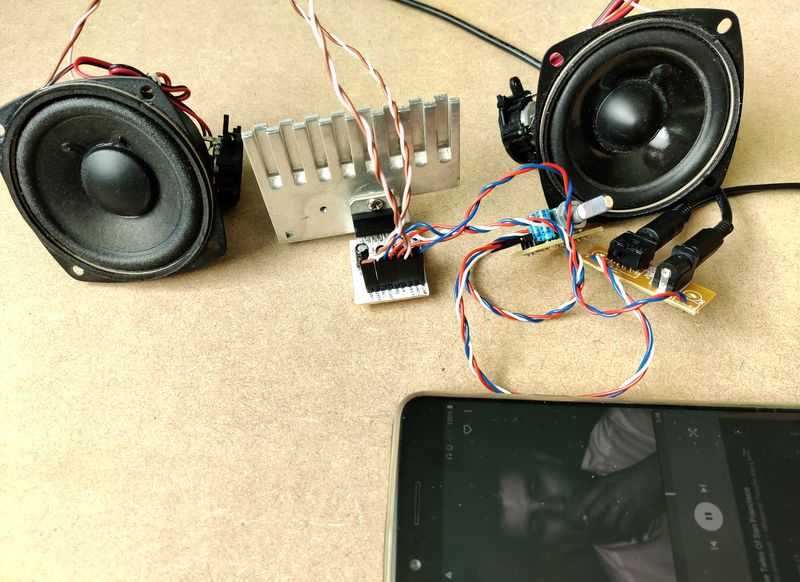
Above: First test of the TDA7297
When wired correctly, the TDA7297 is a great amplifier. It sounds absolutely fine and is perfect for driving small speakers and even larger speakers. Because of the limited power output, speakers with high sensitivity are best if you need high volume, but on most speakers it's absolutely capable for indoor use.
As already mentioned, this amplifier is also applicable for your low power battery operated devices too. You can't go lower than 6V with the TDA7297, but the TDA7266 detailed below allows you to go right down to 3V. At these voltages, there's hardly any benefit to go for smaller amplifiers I used to use, such as the TDA2822M, TDA7052, LM386, because they won't be much smaller or cheaper than these TDA7297/TDA7266 circuits.
The performance might not be quite as good as the superstar STA540, but it's still really good, and has the benefit of being a little simpler to build. Certainly the TDA7297 makes a great and versatile amplifier that will fit many applications perfectly.
TDA7266 application
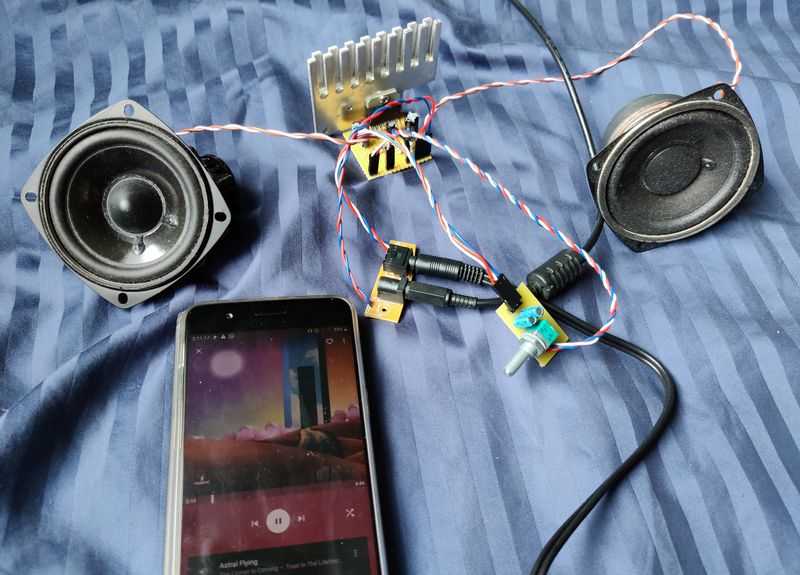
Above: First test of the TDA7266
Quick facts TDA7266
- Power output: 7W + 7W into 8 ohms at 10% 1kHz distortion with power supply 11V
- Power output: 5W + 5W into 8 ohms at 1% 1kHz distortion with power supply 11V
- Power output: 300mW + 300mW into 8 ohms at 1% 1kHz distortion with power supply 4V
- Gain: 32dB fixed
- Power supply: 3V to 18V single supply
- Class AB
- Datasheet available here
The TDA7266 will drop right into the same circuit board for the TDA7297 without any change in components.
Therefore, read the above guide since it is just as appropriate.
It's also a popular amplifier chip and I found one was used in my dead Pure Tempus DAB clock radio (this is the TDA7266S version). De-soldered and put in the same application circuit as the datasheet suggests allows it to live again!
Once again performance on driving 4 ohm speakers is unknown, but again it appears to be fine and the DAB radio mentioned above had 4 ohm speakers anyway, although the power supply was 12V DC (unregulated).
The performance of the chip looks to be exactly the same as the TDA7297 and there appears to be no difference in the maximum allowed voltage and the power output at these higher voltages than the TDA7297.
The typical performance figures though are quoted at a lower 11V vs the 16.5V for the TDA7297. The TDA7266 can also run from a lower voltage of 3V. This all implies that the TDA7266 is really more suited to lower voltage applications and should you have a higher voltage, higher power use case, I'd recommended to go for the TDA7297 instead of pushing the TDA7266.
Otherwise, the use cases of the TDA7266 are exactly the same. It's a great amp and because it can even operate off 3V at its absolute minimum, so why not consider it as a superior alternative over small amplifiers like the LM386, TDA2822M, TDA7052 and the like? I will from now on!
TDA7266M mono application
The TDA7266M is a mono version of the TDA7266. It's basically the same as the TDA7266 but one channel less. This means it's the same 15 pin Mulitwatt package and the same schematic, just with the second channel absent (no connections).
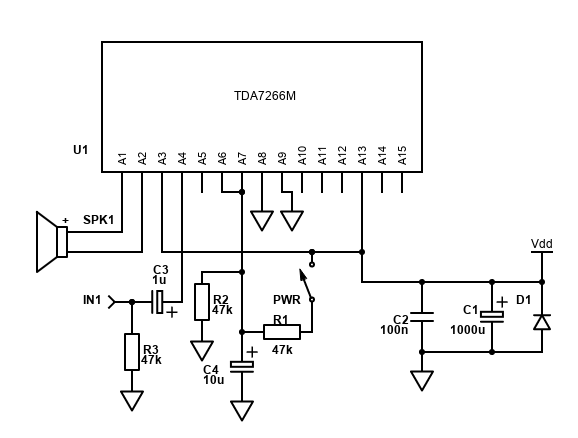
Above shows the adjusted schematic without the second channel. Most of the right hand side of the chip now has no connections, but note that the power supply still needs to be connected to pin 13.
Apart from the reduced schematic, all the above guidance for the TDA7297/TDA7266 applies so please read through.
Because the TDA7266M is in the same Multiwatt15 package, we can still build it on stripboard/veroboard. Below is layout that is slightly smaller than the stereo version.
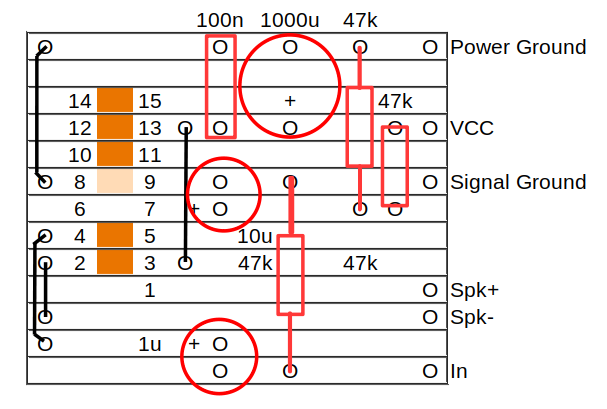
I've not built or tested a TDA7266M, but it should perform pretty much the same as the stereo TDA7266. Because now there is only one amplifier operating within the package, you can use a smaller heatsink which is just over half the size (performance actually) of the heatsink needed for a stereo chip.
It should perform well, and much better than other mono alternatives such as the LM386, TDA2822M (bridged), TDA7052 and so on. If you have a mono application that demands more performance and power though, consider the TDA7391 or TDA7396 chipamps instead.
